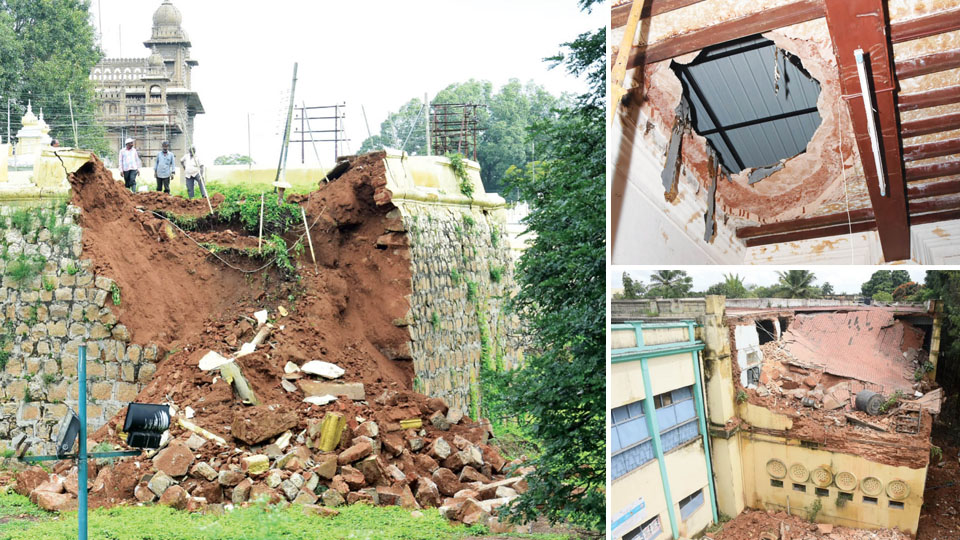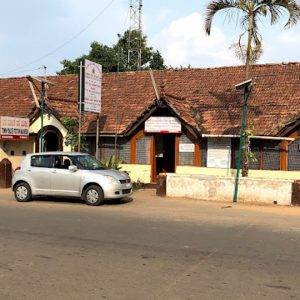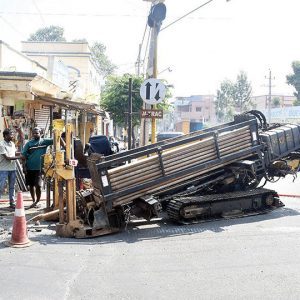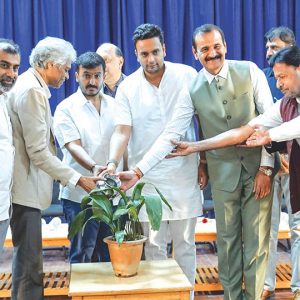By Gouri Satya, Senior Journalist
The recent reports about the fate of heritage structures in quick succession come as a shock and bring to focus once again the monumental neglect of the age-old buildings by the authorities concerned in Mysuru. The way they are facing decay and damage may turn Mysuru into a city sans heritage soon.
A few weeks ago, there was a report about the deteriorating condition of Jayalakshmi Vilas Mansion which had regained its old charm in 2006 after the Infosys Foundation had restored it at Rs. 1.17 crore. One of the Palaces in the ‘City of Palaces’, this prestigious possession of Mysore University has shockingly reached the stage of falling into decay within a short span of 16 years.
The breach of Kukkarahalli Kere, the city’s popular water-body and the overflowing waters flooding a few buildings of the University came next. After a lapse of several years, it is found now that the discharge valve which safeguards the tank and its banks remained neglected. The ‘Raja Kaluves’ passing through inside and outside the city interlinked tanks and facilitated the discharge of excess water from one tank to the other. But, over the years, they have been neglected and encroachments are blocking the flow of rainwater in many places. As a result, tanks have begun to breach and flood the living areas in and around the city, besides rain waters flooding the roads in the heart of the city during heavy rains.
Next came the shocking news of the collapse of a portion of the Palace Fort Wall. Most people may be unaware that the Fort’s history can be traced to the days when Mysuru was called ‘Puragere’. The ‘Hudevu’ of the 14th century was an irregular mud wall built to protect the dwellers in the small town from wild animals. It also marked the city’s boundary — ‘pura-gere’ or ‘purada-gere’. In the later years, successive rulers of Mysuru reinforced it and Krishnaraja Wadiyar III rebuilt it after it became his capital. Later, Krishnaraja Wadiyar IV had it reconstructed in its present shape and form, making it an attractive fort wall with artistically designed gates.
Soon after this, came the news that the Mysuru City Corporation proposed to change the whole shape of the ‘Fountain Circle’ on Bengaluru-Mysuru Highway by removing the historic Elgin Fountain and ignoring the name of the first President of India, Dr. Rajendra Prasad, as part of its proposal to beautify the Circles in the city. As though not just these alone, now comes the shocking collapse of a portion of the prestigious Maharani’s Science College building which heralded girls’ college education about 122 years ago in the royal city.
Photos posted along with the reports clearly show profuse growth of vegetation in crevices of the Fort and the Maharani’s College. Such dangerous growth of weeds may be seen in many other historic monuments in the city, including the architecturally unique structures in the Maharaja’s College campus. The growth of vegetation in the crevices and cracks is always a threat to the stability and strength of any building and could lead to its collapse as has happened in these two cases.
Apart from these, what causes further concern is the fate of several other neglected structures like the Lansdowne Building, Devaraja Market, Maharaja’s High School, Medical College Hostel, Vasantha Mahal, Vani Vilasa Market and even the Chamundi Hill, the pride of Mysuru. The unscientific and irrational development of the Hill is threatening its very ecology. Water is allowed to seep through instead of facilitating its flow. During the reign of Krishnaraja Wadiyar, the roads were so designed rain waters flowed down from the hills forming ponds and filling up tanks around the foothills. The temporary waterfalls from the hills particularly at the horseshoe valley during monsoon was a fascinating sight. The scenic foothills and the horseshoe valley must have disappeared and the name forgotten with encroachments all around. While writing this piece comes the news of another landslide atop the Hill, the fifth one!
Here it may be recalled that Mysuru has already lost a few historic landmarks like the Purnaiah Choultry, Yele Thota, where the famous Mysuru variety of betel leaves was grown and the portico of the Saraswathipuram Fire Station, besides chosen varieties of avenue trees and aesthetically designed gardens, developed by renowned German horticulturist Krumbiegel, distinguished horticulturist of Mysuru H.C. Javaraya and others.
In this depressing scenario, what may come as surprise is the survival of the historic Lansdowne Building and the functional Devaraja Market bearing the brunt of heavy rains lashing the city. Their survival without any further damage shows that heritage buildings built during the period of the Maharajas can serve for several more years if only they are restored and conserved in a scientific manner and the demand to demolish them has very little justification. Instead of restoring them, these iconic buildings are being allowed to decay further like many more buildings in the city and their fate continues to hang in balance, with no hope of restoration soon.
Any more disdain towards heritage structures, their maintenance and restoration, may lead several more historic assets to meet their end soon. Mysuru was hailed as a ‘heritage city’ till recently. But now this has been conveniently dropped, perhaps realising that the city’s historic buildings and places have no future, pulls and pressures, besides shortage of funds, operating full force.
In the background of this scenario, the candlelight protest to urge the authorities to take immediate steps to ‘Save Mysuru’s heritage’ comes as a relief that there is an awakening among the youngsters about the future of the city. But this campaign needs to be sustained and should not become a one-time effort lest the authorities continue their monumental indifference. They need to be impressed that such continued callousness may lead to the loss of Mysuru’s heritage and tourist places and it is time to make the past the present like in many other countries which care about their heritage structures utmost and make them global attractions.








Article is a perfect Ode to the…. LAZY INDIFFERENT MYSUREAN. Cretins
Journalists like Gauri Sathy keep bleating about dozens of so called heritage structures crumbling in Mysore, and prattle about the destruction of others like Yele Thota for example, , which he says supplied Mysore special beetle leaves. This could have been taken up elsewhere in a farm, after removing this infernal Yele Thota.
This alone demonstrates his lack of awareness of the problems posed by this Yele Thota to the residents nearby. Our house along with others were located near one large group of this Yele Thota, where the water used for growing the beetle leaves was from a large dirty pond,, which was the breeding habitat of Malarial mosquitos. Our family along with others suffered instances of malaria. Also, this Yele Thota was was also the habitat of poisonous snakes. My neighbour’s son died of bites from one variety of poisonous snake-t was breeding cobras, vipers and green snakes etc.., Once, I narrowly escaped from stepping on to another which used to visit our house very regularly. The MCC employed a dozen snake catchers on its roll .
The removal of the Yele Thota was the best work that the MCC had done. We were grateful to the MCC.
Gauri Satthya destroys his case by listing a large numbers of so called heritage structures in need of repairs. For example, the Maharani’s College building mentioned could be reconstructed with a modern building,; a blue plaque on the wall of the new building – like the ones that London buildings carry on new buildings, where iconic buildings once stood, reminding people about the site and its history, would be the ideal solution.
Buildings like Lansdowne building and Devaraja market simply rendered not economically feasible, by 1970s. Others like the Purnayya Choultry which served well to one of my relatives , was simply not maintainable and left un used for long time as the time moved on with different social demands.
Gauri Sthya, if wants to sound credible, should list just 5/6 really iconic structures like for example, Mysore Palace Fort and Chamundi Hill, which really needs to be preserved, and start a movement with like -minded people, to fight for their restoration. He should understand that this city has many other problems like very bad roads, lack of god facilities in KR and Cheluvamba hospital conglomerate, even with the announced funding which is really very inadequate for example.
It is time for this city to move on, restoring really heritage structures worth the merit. That is the sensible approach That is what happens here in New Delhi, where I live now.
Journalists like Gauri Sathy keep bleating about dozens of so called heritage structures crumbling in Mysore, and prattle about the destruction of others like Yele Thota for example, , which he says supplied Mysore special beetle leaves. This could have been taken up elsewhere in a farm, after removing this infernal Yele Thota.
This alone demonstrates his lack of awareness of the problems posed by this Yele Thota to the residents nearby. Our house along with others were located near one large group of this Yele Thota, where the water used for growing the beetle leaves was from a large dirty pond,, which was the breeding habitat of Malarial mosquitos. Our family along with others suffered instances of malaria. Also, this Yele Thota was was also the habitat of poisonous snakes. My neighbour’s son died of bites from one variety of poisonous snake-t was breeding cobras, vipers and green snakes etc.., Once, I narrowly escaped from stepping on to another which used to visit our house very regularly. The MCC employed a dozen snake catchers on its roll .
The removal of the Yele Thota was the best work that the MCC had done. We were grateful to the MCC.
Gauri Satthya destroys his case by listing a large numbers of so called heritage structures in need of repairs. For example, the Maharani’s College building mentioned could be reconstructed with a modern building,; a blue plaque on the wall of the new building – like the ones that London buildings carry on new buildings, where iconic buildings once stood, reminding people about the site and its history, would be the ideal solution.
Buildings like Lansdowne building and Devaraja market simply rendered not economically feasible, by 1970s. Others like the Purnayya Choultry which served well to one of my relatives , was simply not maintainable and left un used for long time as the time moved on with different social demands.
Gauri Sthya, if wants to sound credible, should list just 5/6 really iconic structures like for example, Mysore Palace Fort and Chamundi Hill, which really needs to be preserved, and start a movement with like -minded people, to fight for their restoration. He should understand that this city has many other problems like very bad roads, lack of god facilities in KR and Cheluvamba hospital conglomerate, even with the announced funding which is really very inadequate for example.
It is time for this city to move on, restoring really heritage structures worth the merit. That is the sensible approach That is what happens here in New Delhi, where I live now.
Interesting to read the long list of heritage structures listed by mr Gauri Satya, which includes medical college hostel. He regrets the loss of the Yele Thota, which supplied the Mysore beetle leaves for the avid addicts who chewed it with beetle nut, chunam and tobacco, contracted cancer of the mouth and oesophagus. The working class Myaoreanswho were addicted to this along with those who smoked the famous Ganesha Beedis,-another Mysore iconic product perished in large numbers afflicted with lung cancer died in large numbers.
The residents in the Ramanuja Road corridor, for decades fought with the muniicipal authorities to clear the infernal Yele Thota, which bread malarial mosquitos and was ther abode of poisonous reptiles, the latter crept into households. Incidents of malaria were large asnd frequent, and daily rounds of snake catchers visiting households complained of their reptile visitors were norm! At last, this menace was banished when the Yele Thota was cleared. If you listen to the stories of elderly residents of this Ramanuja Road corridor, they will narrate the horror stores living with a massive breeding ground of mosquitos, downing them with malaria cycles!
It is time that the MCC with other authorities drew up a @Heritage Index’, on a scale of 1 -100 , with 100 being the most iconic heritage structure needing urgent repair/renovation. There has to be a cut off point at say 70 on this index-which will indicate those structures which are considered really heritage and worth saving. The rest have to go. The government and the local authorities have money collected from the tax payers, and their priority must be the current structures like roads and buildings, where the bulk of the money should go for maintenance .
Mr Gauri Satyahas earned fee for his column inches with long list and comments of protecting them. He should also indicate where he thinks the money should come from for their repairs and renovation which are massively expensive. As for the Maharani’s college and the Medical college hostel, they are best served as modern structures, which means replacing them with modern buildings. Tenuous links to Wadiyars such as Lansdowne building and Devaraja Market, do not mean they are really heritage entities., comparing them with the Palalce Fort and Chamundi Hill which need urgent attention.
Two comments by different people are suspiciously similar. And both against the article. They are specific about saving a few monuments which are tourist attractions and the rest as misery of mysoreans. These are prime real-estate if neglected and removed would profit in lakhs of crores.
Sorry, some typos. Should be : bred
Kevin I agree with you sir. Two of the comments are suspicious. If we have problems with nature, then we are the problem. It’s ys that has to be removed and not the other way. We are encroaching upon mother nature.
Hello Kevin and Raj Those posts are not similar, as each one has different expereince, but agree on the Yele Thota and several structures that Gauri Satya mentions which are not worth as heritage structures. If I posted in response, I would have written similar as I lived near Yele Thota suffered from Mosquito bites and bouts of Malaria and encounters with snakes coming out of that Thota. Anyway, I suggest both of yourread the piece that the part of the Yele Thota still exists at 9th cross Ramanuja Road, which is the breeding ground of a crocodile!
@Raj, where is mother nature involved except in Yele Thota. Would you be prepared to be bitten by mosquitos, suffer from Malaria? Would you have liked to meet those poisonios snakes almost every day? You need learning, as you talk nonsense.
@Kevin Your comprehension of heritage is poor at best. Tourists naturally visit Chamundi Hill and Palace because they are really heritage structures. They are not bothered about the list Stya givessuch as :”Lansdowne Building, Devaraja Market, Maharaja’s High School, Medical College Hostel,.. and Poornaiaih Choultry , which demonstrates thast these are not really heritage structures with the value necessary to renovate them.
Both of you are examples, of Mysoreans-if you are, why Mysore today is in such shambolic state with pollution and filth.